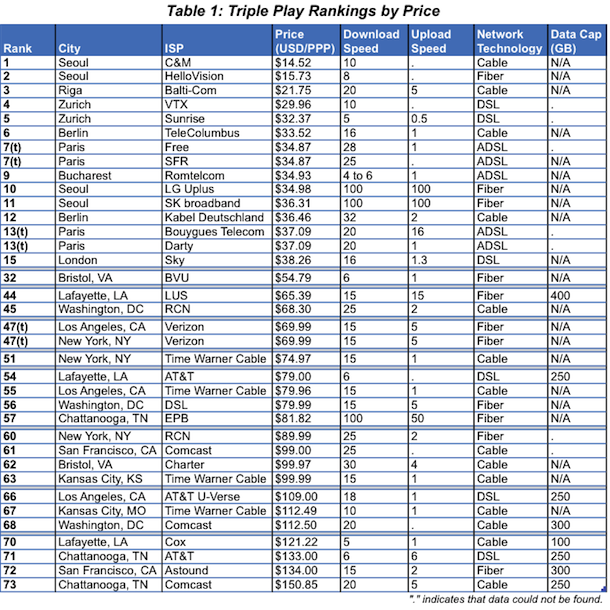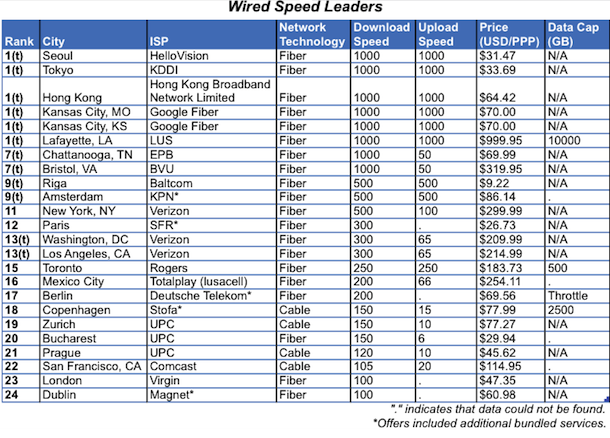U.S. Consumers Paying More, Getting Less For Internet Than Europe & Asia
 While numerous telecoms in Europe and Asia are acknowledging that it’s becoming cheaper and easier to provide TV and high-speed Internet service to consumers, many U.S. providers are continuing to charge high prices for a mediocre product, according to a new report from the New America Foundation’s Open Technology Institute.
While numerous telecoms in Europe and Asia are acknowledging that it’s becoming cheaper and easier to provide TV and high-speed Internet service to consumers, many U.S. providers are continuing to charge high prices for a mediocre product, according to a new report from the New America Foundation’s Open Technology Institute.
The report looks at the wide array of broadband offerings in nearly two dozen markets, including New York, Los Angeles, Kansas City, San Francisco, and Washington, D.C., and found that the most affordable services are generally found when customers bundle Internet service with cable and phone (the well-known Triple Play package), but that even then Americans are paying several times what their counterparts pay overseas.
See the above chart, listing the 15 most-affordable triple play bundles — none of them found in the U.S. — followed by the most affordable bundles in the surveyed American cities.
As you can see, it’s like looking at the Olympics results for one of those sports that the U.S. performs really poorly in, like cross-country skiing, with the lowest-price bundle coming at #32. That bundle from Bristol, Virginia’s fiber network, costs $55/month and only provides 6Mbps download speeds. Consumers in Zurich and Bucharest are getting similar speeds for $20/month less, while one bundle in Seoul provides 8Mbps for only $16/month, 1/3 the cost of the Bristol bundle.
And many of the bundles in the top 15 provide significantly higher speeds, with a median of 20Mbps and an average of 28Mbps. The most affordable triple play bundles in the U.S. with those sorts of speeds are at least $68/month.
In fact, of the 21 most affordable bundles in the U.S., only five advertised speeds above the median 20Mbps of the top 15 from Europe and Asia. The median speed of these U.S. bundles is 10Mbps and the average is 20Mbps.
The median price for those top 15 packages is around $35 with an average of $32. But the most affordable American bundles have a median monthly price of $82 with an average of $90/month.
A previous report from the Open Technology Institute had been criticized by telecom apologists for including rural and suburban areas in its comparison to global markets with dense populations. So for this study, OTI stuck to densely populated areas, many with high-speed fiber lines.
Indeed, there are a handful of cities in the U.S. that offer Gigabit Internet access, and others where consumers can purchase plans advertising speeds faster than 100Mbps, but as you can see from the chart below, the amount people are billed is not always a measure of how fast they can download files:

Google Fiber is available in Kansas City and only charges $70/month for the super high-speed service. While that’s much, much less expensive than the $1,000/month you’d pay in Lafayette, LA, or the $320 you’d pay in Bristol, VA, it’s more than double what consumers pay in Seoul and Tokyo for comparable service.
Cable companies also offer high-speed service stateside, but it’s going to cost you. Verizon customers in NYC, L.A., and D.C. will have to pay hundreds of dollars to get the top speeds available from FiOS, which are only 1/3 to 1/2 as fast as they could get via Google Fiber.
Meanwhile, 500Mbps in Riga, Latvia, costs $9/month and $27/month will get you 300Mpbs in Paris (as part of a triple play bundle).
The OTI has made its entire data set available in an Excel workbook if you want to go crazy sorting and comparing the thousands of available plans and bundles to compare.
Want more consumer news? Visit our parent organization, Consumer Reports, for the latest on scams, recalls, and other consumer issues.

